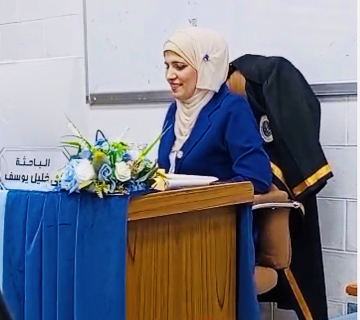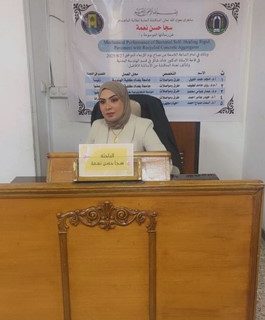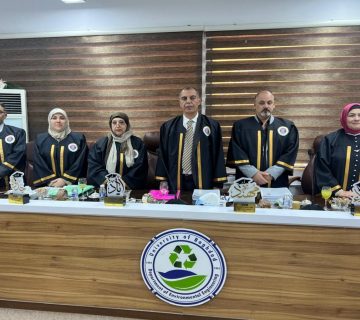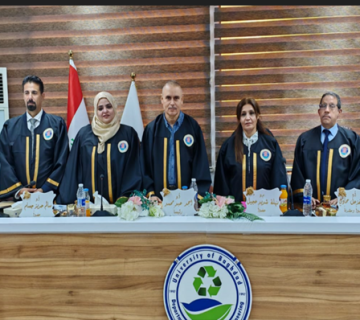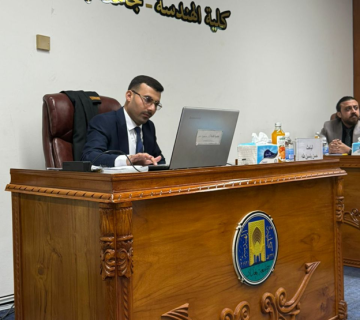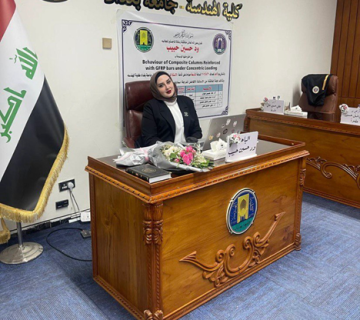The Chemical Engineering Department at the College of Engineering, University of Baghdad, held an PhD thesis examination titled:
“Performance of Membrane Distillation Process for Desalination using Fabricated Electrospun Nanofibers Membrane”
On Sunday 3-11-2024
By the student Nawras Nabeel Safi and supervised by Asst.Prof. Dr Basma Ismael Waisi
The examination committee consisted of Prof. Dr. Hasan Farhood Maki as Chairman and the membership of Prof. Dr. Asrar Al-Obaidy, Asst. Prof. Dr. Malik Mustafa Mohammed, Asst. prof. Dr. Rasha Habeeb Salman
and Asst. Prof. Dr. Atheer M. Al-yaqoobi.
After conducting the public discussion and listening to the student’s defense, the thesis was accepted. The thesis was summarized as follows:
Direct contact membrane distillation, or “DCMD,” is one type of membrane distillation (MD) which is a thermally driven process with moderate operating temperatures .It is a known effective technology for saltwater desalination. This work includes fabricating a novel double-layer of non-woven nanofiber membranes prepared via the electrospinning method using hydrophobic polymers for water desalination brine water with concentrations ranging from 70 to 210 g/L using DCMD system. Electrospun nanofiber membranes have received increasing attention in the membrane distillation (MD) process due to their high porosity and high permeability and surface area. Nanofiber membranes made from pure (one layer) at various polymers PAN/DMF (10 wt.%), PVDF/DMF (10 wt.%) and pure PMMA/DMF (30 wt.%) were prepared to be applied in the MD system. Then the dual-layer membranes were prepared to be applied in the MD system. Electrospun nanofibers based on polyacrylonitrile (PAN) made up the first (base) layer. Then, on the top of the first layer, there are hydrophobic electrospun nanofibers manufactured from polymethyl methacrylate (PMMA). The shape and wetting of a series of two-layer nanofiber membranes produced with varied percentages of PAN: PMMA were analyzed using scanning electron microscopy (SEM) and contact angle measurements. When tested under best conditions (i.e., 70 g/L, 0.6 L/min, and 55 °C) from Taguchi method , the DCMD results showed that the (25 PAN:75 PMMA) membrane rejected more than 99.356% of the salt with a flow of 51.872 kg/m2.h, contact angle 138º and a penetration through conductivity at 334 μs/cm.
Then, a double-layer of nanofibers membranes were prepared via the electrospinning method using hydrophobic polymers. The first (base) layer was hydrophobic polyvinylidene fluoride (PVDF) based electrospun nanofibers. The second (top) layer was hydrophobic polymethyl methacrylate (PMMA) based electrospun nanofibers. A series of dual-layer non-woven nanofiber membranes with various PVDF:PMMA amount percentages were fabricated and characterized regarding their morphology and wetting using scanning electron microscopy and contact angle. The pure water permeate flux of the prepared membrane was enhanced by approximately (25 PVDF: 75 PMMA). When operated under the optimum conditions (i.e., 70 g/L, 0.6 L/min, and 55°C), the direct contact membrane distillation results for the 1 PVDF:3 PMMA membrane demonstrated that its salt rejection was greater than 99.757% with flux 44.192 kg/m2·h, contact angle 142º and a permeate conductivity at 243 μS/cm. From the comparison between these membranes in the results (DCMD) and characterized by using contact angle (CA), Tensile Strength (TS), Atomic force microscopy (AFM), and Scanning Electron Microscopy (SEM). In addition, the porosity and Liquid Enter Pressure (LEP) were calculated for each membrane, and by compare the tests, it is essential to use the Taguchi Method to determine which variables can affect the flux. This method was discovered through the use of Taguchi experimental design, with experiments performed by means of “Taguchi method” an approach that utilizes the “Orthogonal Array” (OA) to limit the amount of experiments and shorten the period of the experimental study, we got the best membrane in proportion 1PVDF:3 PMMA. Due to their unique features, superhydrophobic nanofibers have garnered much attention from scientists working to perfect high-efficiency MD membranes. In this work, a completely novel double-layer design approach for superhydrophobic membranes was proposed for water desalination using (DCMD). Different ratios of silica (SiO2) nanoparticles have been added to the best membrane in proportion 25PVDF:75PMMA at varying amounts of weight (1.0, 1.5, 2.0, 2.5,3.0, 3.5, and 4.0wt. %) within the second (top) layer, which is the PMMA/DMF. Embedding 3.5 wt.% SiO2 nanoparticles within the nanfibers resulted in the highest contact angle of 153º and tensile strength 10 N. The high hydrophobicity increased the repellent water on the membranes and prevented the membranes from being wet.
The DCMD showed that the membrane’s salt rejection was higher than 99.99 % with a water flux of 43.997 kg/m2.h and conductivity below 20.51μS/cm. The ratio of 1 PVDF:3 PMMA with 3.5 wt. % SiO2 nanoparticles was the best in terms of the properties of the wettability and the mechanical strength force with maintaining a high flux. The study examined how the permeate flux was affected by changing the feed concentration, feed temperature, and feed flow rate and optimized within a logical framework. These included feed inlet temperatures between 35 and 55 °C, salt concentrations between 70 and 210 g/L, and rates of supply flow of 0.2, 0.4, and 0.6 L/min. When the feed temperature was increased from 35 to 55 ℃, the penetration flux had a 72-114% rise; when the feed flow rate was increased from 0.2 to 0.6 L/min, the flux had an 11-23% increase; and when the salt concentration in the feed was elevated from zero to 210 g/L, the flux had a 34-44% decrease. It is clear that the DCMD system’s performance in this study is on level with, or even better than, which is stated in the reviewed literature. Also, a MATLAB-based model of the DCMD system’s heat and mass transfers was created. There was a maximum absolute error of less than 20% and the conclusions of the mathematical model were generally agreed well with the results of the experiments. The system achieved a maximum thermal efficiency of 73.5% while the coefficient of temperature polarization for DCMD varied between 0.78 to 0.91. The gain output ratio (GOR) was 0.87. The DCMD system’s performance was optimized using the response surface approach, and the R² coefficient was 95.65 %.



